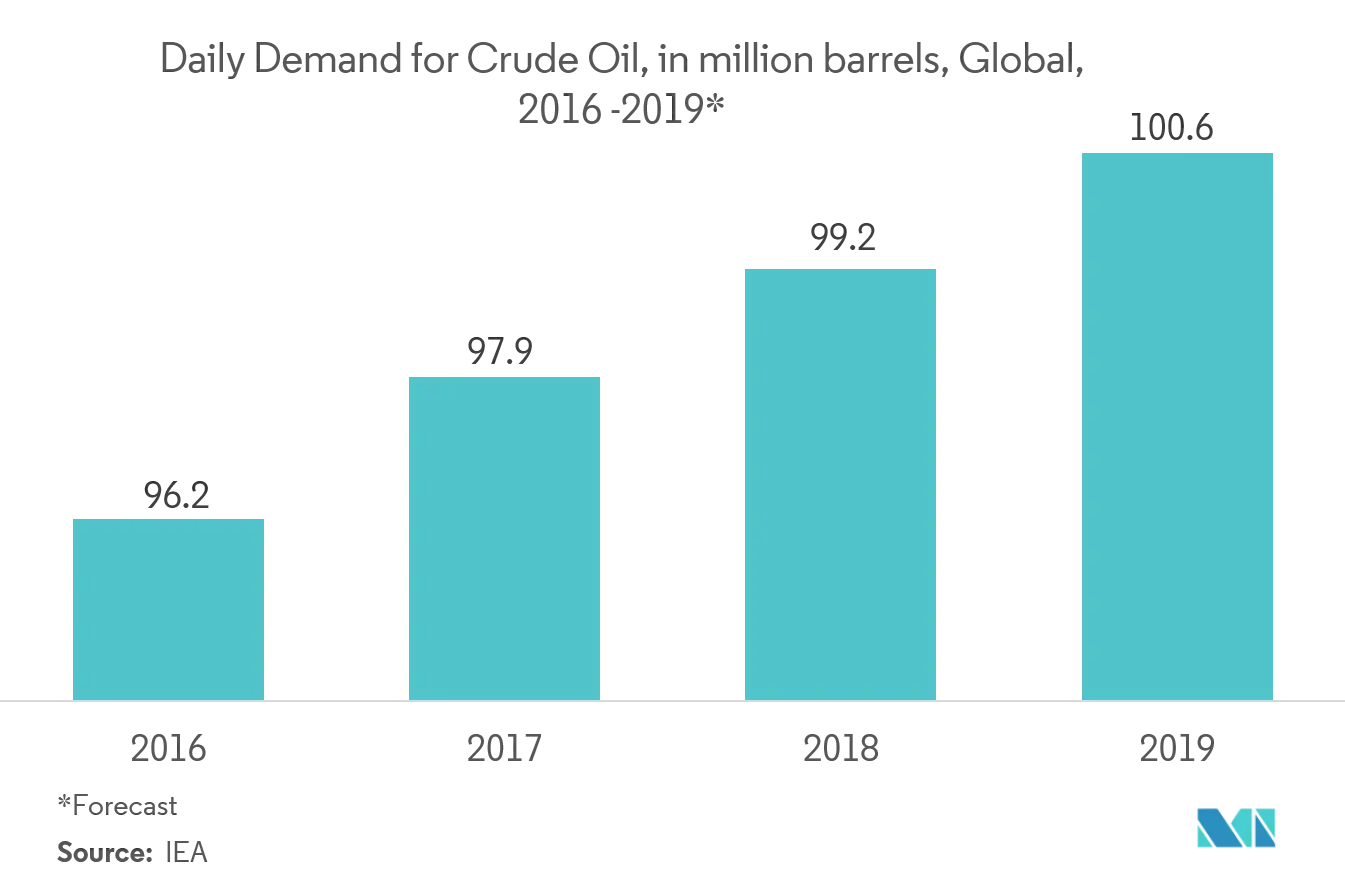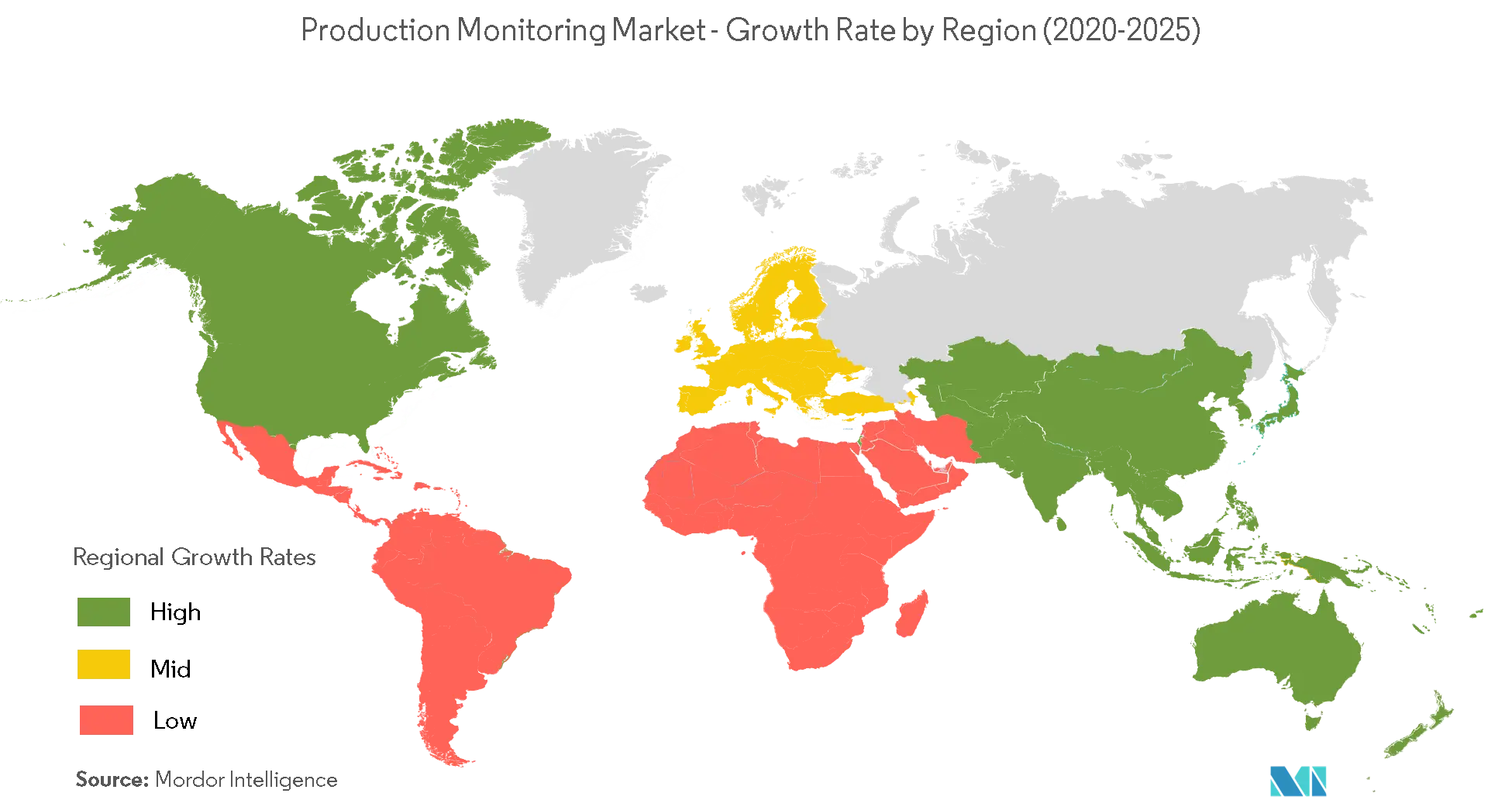Market Trends of Production Monitoring Industry
This section covers the major market trends shaping the Production Monitoring Market according to our research experts:
Automation and Control Management to Witness Significant Growth in Oil and Gas
- According to Forbes, the dependency of the oil and gas industry on automation increased in the last decade, which is further expected to double by 2020 with the increasing demand for crude oil. Initiatives to digitize oil fields are being implemented, which has led to investments in instrumentation to increase productivity and complete projects within defined budgets and timelines.
- The automation sector has evolved from supplying hardware equipment with aftermarket services to becoming more service-based and offering software tools that can translate huge volumes of data into meaningful, intelligent information that can be leveraged to make important business decisions. In April 2019, AeonX Limited (Nigeria) signed the oil and gas partnership agreement with WFS Technologies to promote and deliver the full range of state-of-the-art Seatooth products for asset integrity and flow assurance monitoring to the existing and new clients in Nigeria.
- Furthermore, one of the largest expenses for oil and gas companies comes through the process of drilling. Not only is drilling costly, but it is also highly technical and involves considerable safety risks for workers. Automating manual portions of that process, like pipe handling and pressure drilling, can significantly reduce safety risks and speed up the overall drilling process.
- In April 2020, Brazilian offshore drilling services provider, Ocyan, launched the Ocyan Waves program, where the offshore drilling platforms provide several supervisory systems that connect different equipment by sensors using automation. The systems are able to emit alarms when some equipment exceeds its minimum or maximum index, warning the operator that something is wrong.
- Furthermore, some companies have started using automated weather sensors to detect changes in seismic activity, as well as ocean and atmospheric levels. This can help predict when conditions are right for major natural weather events, such as earthquakes and hurricanes, thereby, enabling oil and gas companies to take the proper safety precautions in real-time. Due to a high degree of automation, the developed technology can be implemented as a geoinformation web service for all-weather up-to-the-date monitoring of oil extraction areas. This web service can be used to determine the area of fields, control production activity, and estimate oil production, supervise development and production activities, and assess anthropogenic load in oil production areas.
- The measurement of pressure and flow of oil is a task that can easily be improved through automation. Installing smart sensors can help in connecting to centralized monitoring software, thus, allowing pressure, flow, and level of oil to be reported remotely from the field, without the need for on-site crew. Upon receiving this information, rig crews can monitor and adjust the settings as needed.
- In April 2020, Yokogawa introduced AI-enabled versions of SMARTDAC+ Paperless Recorders and Data Logging Software, as well as Environmentally Robust AI-enabled e-RT3 Plus Edge Computing Platform, for industry applications, including oil and gas. Recorders used in manufacturing and R&D acquire, display, and record data on voltage, current, temperature, flow rate, pressure, and other process variables in the oil and gas industry.
- Furthermore, due to the COVID-19 pandemic, the strategy to implement automation monitoring is increasing. In April 2020, a Finnish-Russian industrial digital solutions provider, Zyfra, stated that companies in the field of machinery, mining, and oil and gas from Russia and India should focus on speeding up their digital transformation. Zyfra also called upon the companies to jointly develop industrial digitalization technologies and share best practices to minimize the negative consequences of the COVID-19 pandemic on their businesses and supply chains. Hence, the demand for automation production monitoring is expected to significantly increase during the pandemic.

North America Accounts for Significant Market Share
- North America is the largest contributor to the production monitoring market, as the region is technologically advanced. The North American countries have developed infrastructure and skilled workforce, which help the production monitoring solution providers offer 24/7 support and maintenance to their clients.
- In the United States, most of the industries are sophisticated users of data analytics systems, and they are ready to deploy a new platform with new architecture and capabilities to monitor the production. Furthermore, players are focused on providing new solutions. In April 2020, Altair announced a major release of Panopticon, its comprehensive platform for user-driven monitoring and analysis of real-time trading and market data. These include operational data analytics applications in manufacturing, logistics, telecoms, oil and gas production, and energy distribution.
- Furthermore, companies in the United States, where employees are more than 100 in number, are adopting cloud-based applications. It has been estimated that nearly 35% of SMBs in the country have already deployed cloud solutions integrating with BPM (Business Process Optimization). This further holds the ptential for growth for production monitoring in the services segment.
- In March 2020, Sysdig Inc. announced cloud monitoring at scale with full Prometheus compatibility in the United States and Canada. It enables companies to confidently run cloud-native workloads in production. With the Sysdig Secure DevOps Platform, cloud teams embed security, validate compliance, and maximize performance and availability.
- Also, the launch of Predictive Maintenance-as-a-Service (PMaaS) by Rockwell Automation is assisting industries in the United States by providing service on critical assets identified by the customer, analyzing data from connected technologies, such as sensors, control systems, and smart machines, and identifying normal operations and build out data models to help predict, monitor, and mitigate future failures or issues as part of the preventive maintenance strategy.
- According to the U.S. Energy Information Administration, the United States may become a net energy exporter in 2020 and remain so throughout the projection period, as a result of large increases in the production of crude oil, natural gas, and natural gas plant liquids (NGPL), coupled with slow growth in the US energy consumption. This factor is likely to boost the demand for production monitoring solutions at present and in future.
- Furthermore, in the most severe cases of COVID-19, the race to build more ventilators has seen automakers, like Ford, General Motors, and Tesla, morph into ventilator distributors and designers while helping medical device companies to scale up production of the critical equipment. While there were around 160,000-200,000 ventilators in the United States as of mid-March 2020, some health experts believe that as many as 1 million COVID-19 patients may need the devices in the country over the course of the pandemic. This further leads to the usage of production monitoring software to help these companies prevent the shortage in future, based on the situation.

